For me, my African ancestor’s trials of enslavement is not a distant historical occurrence, but something that shaped my family life then and to this very day. I have studied the subject extensively, lectured in many historic cities and countries, and I have been fortunate to preserve many family heirlooms dating back to the early days of African heritage enslavement. But I had never returned to their homeland.
I believe that history is about storytelling. This is my story of reconnecting with my family’s African origins.
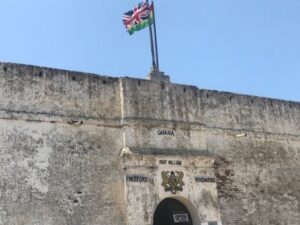 This past August I had the honor to be invited to Accra, Ghana to participate in an historic summit sponsored by the Heritage and Cultural Society of Africa. But it was the very emotional experience of visiting Fort William at Anomabo, where scores of enslaved Africans would embark from and on to the Middle Passage and slavery, that would truly move me. Merchants from my hometown of Newport, Rhode Island were leading slave traders at Anomabo and few today know that Newport was the leading slave port in British North America. Many Africans who landed in Colonial Newport came through Anomabo and today you can find them buried at God’s Little Acre within Newport’s Common Burying Ground.
This past August I had the honor to be invited to Accra, Ghana to participate in an historic summit sponsored by the Heritage and Cultural Society of Africa. But it was the very emotional experience of visiting Fort William at Anomabo, where scores of enslaved Africans would embark from and on to the Middle Passage and slavery, that would truly move me. Merchants from my hometown of Newport, Rhode Island were leading slave traders at Anomabo and few today know that Newport was the leading slave port in British North America. Many Africans who landed in Colonial Newport came through Anomabo and today you can find them buried at God’s Little Acre within Newport’s Common Burying Ground.
As I walked the grounds of Fort William and through the town of Anomabo where my own maternal African ancestor was forced into slavery, what made the experience even more significant was to have the descendant of our family’s enslaver (and later, emancipator) join me along with the Anomabo Elders. Together they helped me to retrace the very footsteps of African men, women and children who were captured by fellow Africans in the interior of Africa, marched to the coast and placed in the cramped, dirty dungeons to await transport to either the West Indies or seaports in early America. Today, scholars of the Trans-Atlantic Trade recognize Anomabo as the center of the British Slave Trade along the West African Gold Coast and one of the largest exporters of enslaved Africans to the West Indies and North America.
So here I am walking through an 18th century fort that served as a major entry point for scores of Africans into permanent enslavement, an African heritage man from America walking with a European heritage man from England and African Elders of Anomabo all seeking to understand why we are still all so very connected centuries later.
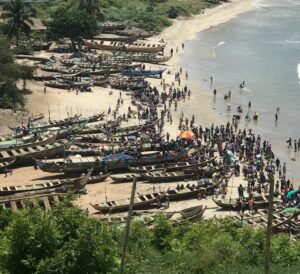 My first reaction was how beautiful the ocean and beach looked as a backdrop to an immense, white stone colonial fort. But the natural beauty of the area masked an ugly occurrence: the lives of enslaved Africans who once were captured and imprisoned in this very same pastoral place. As I walked to an overlook, I could see the beach lined with fishing canoes, which I was told had existed as far back as the time of my own ancestor. The bucolic scene of fishing vessels and beachfront markets of today were buoyed with the somber recollection that similar vessels during the Colonial Era were used to transport the enslaved to British slave ships at anchor, waiting to take the next load of men, women and children to their wretched destinies.
My first reaction was how beautiful the ocean and beach looked as a backdrop to an immense, white stone colonial fort. But the natural beauty of the area masked an ugly occurrence: the lives of enslaved Africans who once were captured and imprisoned in this very same pastoral place. As I walked to an overlook, I could see the beach lined with fishing canoes, which I was told had existed as far back as the time of my own ancestor. The bucolic scene of fishing vessels and beachfront markets of today were buoyed with the somber recollection that similar vessels during the Colonial Era were used to transport the enslaved to British slave ships at anchor, waiting to take the next load of men, women and children to their wretched destinies.
Walking through the fort and town I felt like some kind of historical survivor of the long ago Trans-Atlantic Slave Trade that brought over ten million men, women and children to places like Jamaica and Newport. Understanding through my years of research about the brutality of the slavery system coupled with constant menace of disease and injury, how was it my ancestors survived? But they did survive and here I am, the living proof of their resiliency and “creative survival” presently following their very footsteps hundreds of years later feeling humble and reflective.
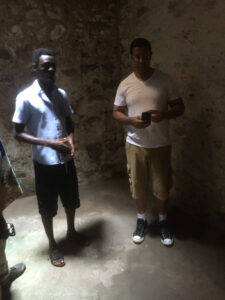 My initial reaction of feeling like a survivor of some long ago history of African enslavement, was soon replaced with feelings of solemnness as I began to move through the fort’s cramped corridors and dungeons that in some cases would hold hundreds of human beings. As part of the insidious, but highly organized system of containment, cells were divided into those for men, women, children and the smallest and darkest reserved for those who dared to resist their captivity.
My initial reaction of feeling like a survivor of some long ago history of African enslavement, was soon replaced with feelings of solemnness as I began to move through the fort’s cramped corridors and dungeons that in some cases would hold hundreds of human beings. As part of the insidious, but highly organized system of containment, cells were divided into those for men, women, children and the smallest and darkest reserved for those who dared to resist their captivity.
My tour guide, a young and earnest man, described how captives would remain in the concrete cells mostly in darkness, for nearly a month. Those who survived the captivity and deprivation were taken through a passage way leading to a door that opened to the beachfront where waiting fishing vessels transported them to sailing ships. There, they endured several weeks in the cramped holds as cargo of the barely living, to eventually arrive at their final destination, which often times was a sugar plantation in the West Indies or less frequently, a Colonial America seaport such as Newport.
After touring the slave fort, I had the uplifting and very emotional experience to participate in a Libation Ceremony with the Elders of Anomabo. A Libation Ceremony is a ritual pouring of a liquid as an offering to a god or spirit in memory of the dead. Knowing my family history, my 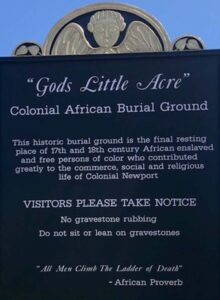 friends historian Chandler Saint and Professor Kwadwo Opoku-Ageyemang from the University of Cape Coast had arranged for me to meet the local chief and his elders so that we could perform a ceremony in the memory of my own and all the ancestors that perished and survived Fort William. I had brought with me earth in a small mason jar from Newport’s God’s Little Acre Burying Ground that contains America’s oldest and largest collection of markers of enslaved and later free Africans. The earth was taken from areas of burial markers that included the Akan-people day names of Kofi (Cuffe), Kwame (Quamine), Kojo (Cudjo) and my own ancestors who began with the name Ottobah and later the given name of Barclay.
friends historian Chandler Saint and Professor Kwadwo Opoku-Ageyemang from the University of Cape Coast had arranged for me to meet the local chief and his elders so that we could perform a ceremony in the memory of my own and all the ancestors that perished and survived Fort William. I had brought with me earth in a small mason jar from Newport’s God’s Little Acre Burying Ground that contains America’s oldest and largest collection of markers of enslaved and later free Africans. The earth was taken from areas of burial markers that included the Akan-people day names of Kofi (Cuffe), Kwame (Quamine), Kojo (Cudjo) and my own ancestors who began with the name Ottobah and later the given name of Barclay.
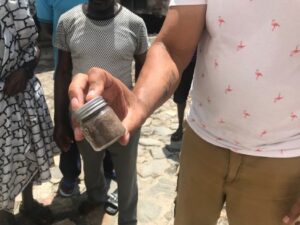 The ceremony began with an elder identifying a spot near a wall where captive Africans were lined up for inspection. I joined the elder and others in digging a small hole and placed the contents of the jar as I was instructed to bury it with my own hands. Next, another elder began pouring liquid over the freshly buried site and would offer words that others in the group would respond to. I was told what was said over the site included “We call upon our ancestors and their unconquerable spirit, for they are the foundation of today.” The ceremony continued with a statement that “We pour in remembrance of our struggle and all those who have struggled on our behalf.”
The ceremony began with an elder identifying a spot near a wall where captive Africans were lined up for inspection. I joined the elder and others in digging a small hole and placed the contents of the jar as I was instructed to bury it with my own hands. Next, another elder began pouring liquid over the freshly buried site and would offer words that others in the group would respond to. I was told what was said over the site included “We call upon our ancestors and their unconquerable spirit, for they are the foundation of today.” The ceremony continued with a statement that “We pour in remembrance of our struggle and all those who have struggled on our behalf.”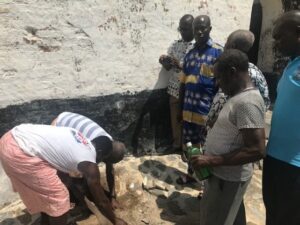 At the conclusion of the ceremony, I was directed to place earth from the exact spot into my jar, so that I could return soil to Newport, so that a piece of Africa could be rejoined with those at internal rest in America, thus completing the circle. As I walked away from the freshly covered earth, I had wished that every person of African heritage across the African Diaspora would experience my feelings of both sorrow and pride.
At the conclusion of the ceremony, I was directed to place earth from the exact spot into my jar, so that I could return soil to Newport, so that a piece of Africa could be rejoined with those at internal rest in America, thus completing the circle. As I walked away from the freshly covered earth, I had wished that every person of African heritage across the African Diaspora would experience my feelings of both sorrow and pride.
Before our group would leave the slave fort, the tour guide escorted me through a long, cramped hallway that led to an ancient door that was fastened shut with a large piece of timber. I was told this is the “Door of No Return” at Fort William. When the British slave ships arrived at the fort, the African captives that had survived weeks of darkness, illness and brutality would be chained and taken through the door and led to the waterfront , never to return to their native African soil again.
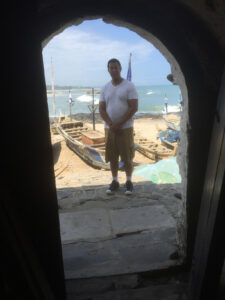 The tour guide lifted the heavy timber from the door and opened it to display a beautiful scene of sunlight looking down onto the beach. He asked me to step through the door and stand on the beach. My first thought was he wanted me to personally experience the last sights of the African captives, but instead he exclaimed with a smile, “Now that you have returned to Anomabo and brought back the remains of those who were taken away, it will now be called for you, the “Door of Return”
The tour guide lifted the heavy timber from the door and opened it to display a beautiful scene of sunlight looking down onto the beach. He asked me to step through the door and stand on the beach. My first thought was he wanted me to personally experience the last sights of the African captives, but instead he exclaimed with a smile, “Now that you have returned to Anomabo and brought back the remains of those who were taken away, it will now be called for you, the “Door of Return”
As I left Anomabo to return to Accra and the Summit with the theme of “Linking, Reconciling and Reuniting Communities in the African Diaspora,” many questions danced in my head, further fueling my feelings of survivorship, and a second personal journey travelling through small villages and towns that would challenge the very core of my feelings on the impacts of slavery past and present. As I was passing by and through some Ghanaian neighborhoods, I was overwhelmed with the abject poverty so many Africans, particularly children, were living in. My feelings of survivorship turned to relief for my luck and privilege. Through my own African ancestor’s “creative survival” I have the privilege today to reflect on the pain of historic slavery, but I was more shaken by the present-day images of people who look like myself and family still not benefiting from the economic and social fruits of freedom in the 21st century. Poor neighborhoods in Ghana were painfully similar to poor neighborhoods that I have seen in Bahamas, Barbados, Jamaica, and even in cities in America like New York and Chicago. All linked with far too many people and families of African heritage living in poverty with little opportunity for personal health, happiness and prosperity. I am beginning to believe the story of slavery of the past has evolved into a story of economic and social injustice in the present.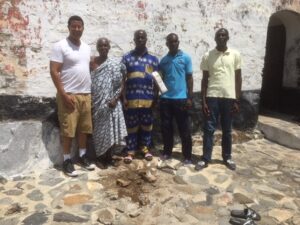
So my long journey of ancestral discovery and coming to terms with the painful history of human bondage has evolved into a new and important question. What is the value of freedom if the present day conditions of poverty are not very much removed from the conditions of past slavery and colonization? I have come away feeling the past and present are not that very different. If true, then maybe our obligation today is to not only to remember the past, but to also actively invest in our people, breaking the cycle of human injustice in our shared history.
- Saving Old Glory - March 31, 2023
- Keith Stokes receives Outstanding Achievement in Leadership Award - December 22, 2022
- Harriet Jacobs - December 22, 2022
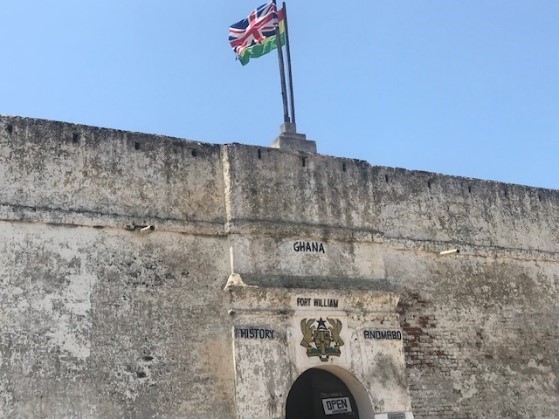


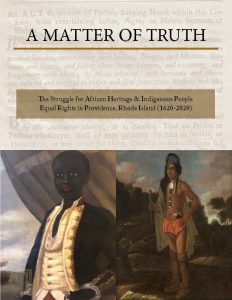 Click on image to view pdf
Click on image to view pdf
Leave a Reply